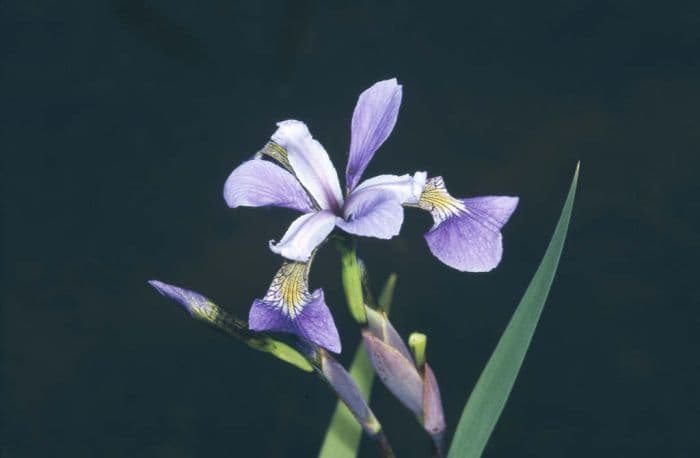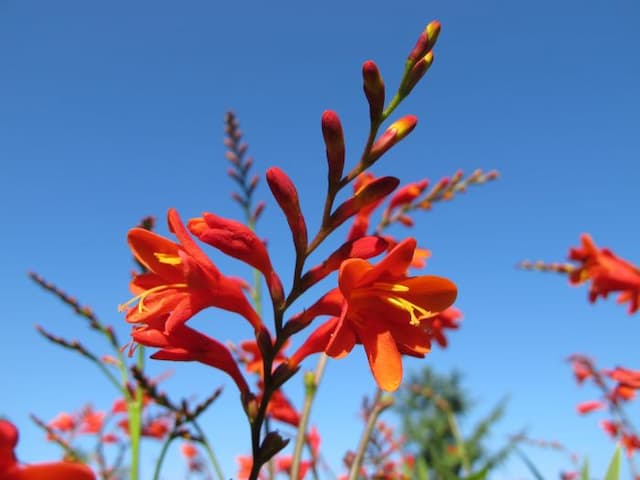Iris versicolor

ABOUT
The plant known commonly as Blue Flag Iris is notable for its showy flowers and sword-like foliage. The blooms are typically a striking blue to violet color, occasionally showing a mix of purples, lavenders, and even whites. Each flower has three large, downward-curving sepals known as "falls," which are often adorned with attractive veining or patterning and can have a splash of yellow at the base. Above these falls are three smaller, upright petals called "standards," contributing to the flower's distinctive form. The leaves of Blue Flag Iris are long, slender, and green, resembling thick blades of grass. They emerge from the base of the plant in a fan-like arrangement, which adds an architectural element to its appearance. The foliage can often persist in attractive clumps, even when the plant is not in bloom, providing a point of interest in the garden. Together, these features make the Blue Flag Iris a popular choice for water gardens and boggy areas, where its affinity for moisture and its vibrant flowers can be showcased. The plant's robust yet delicate look allows it to add color and vertical structure to diverse landscape settings.
About this plant
 Names
NamesFamily
Iridaceae.
Synonyms
Blue Flag, Harlequin Blueflag, Larger Blue Flag, Northern Blue Flag, Poison Flag, Water Flag, Flag Lily, Fleur-De-Lis.
Common names
Iris boltoniana, Iris halo, Iris versicolor var. shrevei, Iris versicolor f. grahamii, Iris shrevei, Limniris versicolor, Xiphion versicolor.
 Toxicity
ToxicityTo humans
Blue flag, the common name for Iris versicolor, contains several toxic compounds, including iridin, which can cause gastrointestinal distress if ingested. Symptoms of poisoning from this plant may include nausea, vomiting, abdominal pain, and diarrhea. Severe cases can lead to increased salivation, lethargy, and even liver damage. It's essential to avoid consuming any part of the blue flag plant.
To pets
Blue flag is also toxic to pets due to the presence of iridin and other compounds. If a pet consumes parts of the blue flag plant, they may exhibit signs of toxicity similar to those in humans, such as vomiting, diarrhea, drooling, or abdominal pain. It's important to keep pets away from this plant and seek veterinary care if they show any symptoms of poisoning after possible ingestion.
 Characteristics
CharacteristicsLife cycle
Perennials
Foliage type
Deciduous
Color of leaves
Green
Flower color
Mixed
Height
2-3 feet (0.6-0.9 meters)
Spread
1-2 feet (0.3-0.6 meters)
Plant type
Herb
Hardiness zones
3
Native area
North America
Benefits
 General Benefits
General Benefits- Aesthetic appeal: Iris versicolor, commonly known as Blue Flag Iris, adds beauty to gardens with its striking blue-violet flowers, enhancing visual interest and creating a focal point in landscapes.
- Pollinator attraction: The Blue Flag Iris attracts bees, butterflies, and other pollinators, supporting local ecosystems and biodiversity.
- Wetland planting: Being a water-loving plant, it is ideal for planting in wet areas of the garden or by water features, helping to stabilize soil and reduce erosion.
- Low maintenance: Once established, the Blue Flag Iris is a low-maintenance plant that requires minimal care, making it ideal for gardeners of all levels.
- Culinary use: Historically, the root of the Blue Flag Iris was used to flavor beverages and as a thickener, though caution is advised due to potential toxicity if not prepared correctly.
 Medical Properties
Medical Properties- Diuretic: Iris versicolor has been traditionally used to promote the production of urine.
- Emetic: The rhizomes can induce vomiting when taken in large doses.
- Cathartic: It has been used to facilitate bowel movements.
- Antibacterial: Components of iris versicolor have shown potential antibacterial properties in studies.
- Bile production: It is said to stimulate the production of bile, aiding in digestion and liver function.
- Anti-inflammatory: There is historical usage of iris versicolor to treat conditions involving inflammation.
 Air-purifying Qualities
Air-purifying QualitiesThis plant is not specifically known for air purifying qualities.
 Other Uses
Other Uses- Iris versicolor, commonly known as Harlequin Blueflag, is often used in the art of plant dyeing, where its rhizomes can produce green and yellow dyes.
- In traditional basketry, the strong fibers from the leaves of Harlequin Blueflag can be used for weaving baskets.
- This plant’s striking appearance often makes it a subject for photographers and botanical illustrators looking to capture its unique beauty.
- Garden designers may utilize Harlequin Blueflag to create "rain gardens" which can help in stormwater management and preventing erosion.
- Educational institutions may use Harlequin Blueflag in botany classes for studying plant morphology due to its distinct flower structure.
- Harlequin Blueflag is used in the practice of companion planting, as its presence can deter certain pests from more susceptible plants.
- Culinary artists sometimes use the vibrant petals of Harlequin Blueflag for plating aesthetics, although the plant is not edible.
- Environmentally conscious efforts employ Harlequin Blueflag in habitat restoration projects, as it is native to wetlands of North America.
- In floristry, although not commonly used due to possible toxicity, Harlequin Blueflag occasionally appears in floral arrangements for its unique look.
- Nature enthusiasts sometimes use Harlequin Blueflag plants to attract butterflies, as they are a nectar source for certain butterfly species.
Interesting Facts
 Feng Shui
Feng ShuiBlue Flag Iris is not used in Feng Shui practice.
 Zodiac Sign Compitability
Zodiac Sign CompitabilityBlue Flag Iris is not used in astrology practice.
 Plant Symbolism
Plant Symbolism- Faith: Iris versicolor, commonly known as Harlequin Blueflag, often symbolizes faith, reflecting its reliable and recurring blooms.
- Hope: The Harlequin Blueflag represents hope, an embodiment of the belief that good things will come.
- Wisdom: This plant is associated with wisdom, often linked to the Greek goddess Iris, who was a messenger of the gods and a symbol of communication and messages.
- Courage: The iris, in general, is a symbol of courage, honoring its bold colors and stately appearance that stands out in the garden.
- Purity: With its striking and clean bloom, the Harlequin Blueflag is also a symbol of purity and innocence.
 Water
WaterThe Blue Flag Iris, commonly known as Iris versicolor, prefers moist to wet soil conditions and should be watered deeply to ensure that the roots receive adequate moisture. It is advisable to provide the plant with about 1 to 2 gallons of water per week, although the exact amount can vary depending on climate conditions and soil type. During the growing season, especially in dry periods, the soil should never be allowed to dry out completely. Watering is often reduced during the dormant season, but the soil should still remain moist.
 Light
LightThe Blue Flag Iris thrives in full sun to partial shade. The best spot for this plant would be an area that receives at least six hours of direct sunlight per day but is also protected from the intense afternoon sun. Dappled light conditions can be ideal, especially in hotter climates, where some shade during the peak heat of the day can prevent scorching of the leaves.
 Temperature
TemperatureThe Blue Flag Iris is hardy and can withstand temperatures as low as -30°F and as high as 90°F. However, the ideal temperature range for this plant is between 50°F and 70°F. It is important to protect the plant from extreme cold by providing mulch or shelter during the coldest months if the temperature approaches its minimum survival range.
 Pruning
PruningPruning the Blue Flag Iris involves removing any dead or damaged leaves and stems to maintain plant health and appearance. It is best to prune after flowering, typically in late summer, to prepare the plant for the next growing season. Periodic thinning of the clumps every 3 to 5 years encourages rejuvenation and more vigorous blooming.
 Cleaning
CleaningAs needed
 Soil
SoilNorthern Blue Flag thrives in acidic to neutral soil, with an ideal pH range of 5.0 to 7.0. A soil mix that is high in organic matter, such as a combination of peat moss, loamy garden soil, and some sand for improved drainage, is recommended to ensure the plant has the moisture it requires while also preventing waterlogged conditions.
 Repotting
RepottingNorthern Blue Flag should be repotted every 2-3 years. This provides fresh nutrients and helps to manage its size, as it can spread quite vigorously in favorable conditions.
 Humidity & Misting
Humidity & MistingNorthern Blue Flag prefers high humidity levels but is quite adaptable and can tolerate the varying humidity levels typical of outdoor environments.
 Suitable locations
Suitable locationsIndoor
Grow Northern Blue Flag indoors with bright light and moist soil.
Outdoor
Place Northern Blue Flag in a bog-style garden or by water.
Hardiness zone
3-9 USDA
 Life cycle
Life cycleIris versicolor, commonly known as Harlequin Blueflag, begins its life cycle as a seed which, after a period of dormancy, germinates in early spring. Seedlings establish a root system and grow into juvenile plants, developing characteristic sword-shaped leaves. This perennial expands through rhizomes, underground stems that grow horizontally, producing new shoots and roots. In late spring to early summer, the Harlequin Blueflag reaches maturity and produces showy, blue-violet flowers, which are pollinated by insects, leading to the development of seed-containing capsules. After flowering, the plant's above-ground parts die back to the ground, and the rhizomes persist through winter, storing energy for the next growing season. With the return of warm weather, the cycle resumes as new growth emerges from the rhizomes.
 Propogation
PropogationPropogation time
Spring to Summer
The most popular method of propagating the Blue Flag Iris, Iris versicolor, is by dividing its rhizomes. This process is ideally done in late summer after the flowering period has finished or in early fall. Gardeners should carefully dig up the clumps of the Blue Flag Iris, being cautious not to damage the rhizomes excessively. Once excavated, the rhizomes should be separated by snapping them apart at the natural divisions. Each section should have at least one fan of leaves attached to ensure successful planting. The divisions should then be replanted promptly, setting them a few inches deep, about 3 to 4 inches (7.6 to 10.2 cm), into the soil and spaced approximately 18 to 24 inches (45.7 to 61 cm) apart to allow for growth. They should be watered well to establish and should continue to receive consistent moisture through the first growing season to encourage strong root development.









